Trace Metals in Amazonian Rivers Sediments from Northern Brazil: Spatial-Temporal Variations, Sources, and Ecological Risks
Abstract
1. Introduction
2. Materials and Methods
2.1. Study Area and Sampling Site
2.2. Sediment Sampling and Pretreatment
2.3. Sediment Characterization
2.4. Analysis of Trace Metals
2.5. Assessment of Sedimentary Contamination Levels
2.5.1. Geoaccumulation Index (Igeo)
2.5.2. Enrichment Factor (EF)
2.5.3. Mean-ERM-Quotient (M-ERM-Q)
2.6. Statistical Analysis
3. Results
3.1. Sediment Characterization
3.2. Spatial and Seasonal Distribution of Trace Metals in Sediments and Sediment Quality Guidelines
3.3. Sediment Contamination Assessment
3.3.1. Geoaccumulation Index (Igeo)
3.3.2. Enrichment Factor (EF)
3.3.3. Mean-ERM-Quotient (M-ERM-Q)
3.4. Statistical Analysis
4. Conclusions
Author Contributions
Funding
Institutional Review Board Statement
Informed Consent Statement
Data Availability Statement
Acknowledgments
Conflicts of Interest
Abbreviations
| MRB | Metropolitan Region of Belém |
| COrg | Organic Carbon |
| LARO | Organic Residue Analysis Laboratory |
| IEC | Evandro Chagas Institute |
| USEPA | United States Environmental Protection Agency |
| IGeo | Geoaccumulation Index |
| EF | Enrichment Factor |
| ERM | Median Range Effects |
| OM | Organic Matter |
| TEL | Threshold Effect Level |
| PEL | Probable Effect Level |
| SD | Standard Deviation |
| CV | Variable Coefficient |
| BV | Background Values |
| PCA | Principal Component Analysis |
References
- Mondal, P.R.; Schintu, M.; Marras, B.; Bettoschi, A.; Marrucci, A.; Sarkar, S.K.; Chowdhury, R.; Jonathan, M.P.; Biswas, J.K. Geochemical Fractionation and Risk Assessment of Trace Elements in Sediments from Tide-Dominated Hooghly (Ganges) River Estuary, India. Chem. Geol. 2020, 532, 119373. [Google Scholar] [CrossRef]
- Wang, M.-H.; Wang, L.K.; Hung, Y.-T.; Shammas, N. Environmental and Natural Resources Engineering; Springer Nature: London, UK, 2021; Volume 19, Available online: http://www.springer.com/series/7645 (accessed on 3 December 2024).
- Zhao, Q.; Bai, J.; Gao, Y.; Zhang, G.; Lu, Q.; Jia, J. Heavy Metal Contamination in Soils from Freshwater Wetlands to Salt Marshes in the Yellow River Estuary, China. Sci. Total Environ. 2021, 774, 145072. [Google Scholar] [CrossRef]
- Liu, J.; Liu, R.; Yang, Z.; Kuikka, S. Quantifying and Predicting Ecological and Human Health Risks for Binary Heavy Metal Pollution Accidents at the Watershed Scale Using Bayesian Networks. Environ. Pollut. 2021, 269, 116125. [Google Scholar] [CrossRef]
- Antoniadis, V.; Levizou, E.; Shaheen, S.M.; Ok, Y.S.; Sebastian, A.; Baum, C.; Prasad, M.N.; Wenzel, W.W.; Rinklebe, J. Trace Elements in the Soil-Plant Interface: Phytoavailability, Translocation, and Phytoremediation—A Review. Earth Sci. Rev. 2017, 171, 621–645. [Google Scholar] [CrossRef]
- Hoang, H.; Chiang, C.; Lin, C.; Wu, C.; Lee, C.; Cheruiyot, N.K.; Tran, H.; Bui, X. Human Health Risk Simulation and Assessment of Heavy Metal Contamination in a River Affected by Industrial Activities. Environ. Pollut. 2021, 285, 117414. [Google Scholar] [CrossRef]
- Ferreira, A.; Horta, M.A.P.; de Cunha, L.N. Avaliação das Concentrações de Metais Pesados no Sedimento, na Água e nos Órgãos de Nycticorax nycticorax (Garça-da-noite) na Baía de Sepetiba, RJ, Brasil. J. Integr. Coast Zone Manag. 2010, 10, 229–241. (In Portuguese) [Google Scholar] [CrossRef]
- Kumar, V.; Pandita, S.; Setia, R. A Meta-Analysis of Potential Ecological Risk Evaluation of Heavy Metals in Sediments and Soils. Gondwana Res. 2022, 103, 487–501. [Google Scholar] [CrossRef]
- Håkanson, L. An Ecological Risk Index for Aquatic Pollution Control. A Sedimentological Approach. Water Res. 1980, 14, 975–1001. [Google Scholar] [CrossRef]
- Carrillo, K.C.; Rodríguez-Romero, A.; Tovar-Sánchez, A.; Ruiz-Gutiérrez, G.; Fuente, J.R.V. Geochemical Baseline Establishment, Contamination Level and Ecological Risk Assessment of Metals and As in the Limoncocha Lagoon Sediments, Ecuadorian Amazon Region. J. Soils Sediments 2021, 22, 293–315. [Google Scholar] [CrossRef]
- de Andrade, L.C.; Tiecher, T.; de Oliveira, J.S.; Andreazza, R.; Inda, A.V.; Camargo, F.A.d.O. Sediment Pollution in Margins of the Lake Guaíba, Southern Brazil. Environ. Monit. Assess. 2017, 190, 3. [Google Scholar] [CrossRef]
- Carrillo, K.C.; Drouet, J.C.; Rodríguez-Romero, A.; Tovar-Sánchez, A.; Ruiz-Gutiérrez, G.; Fuente, J.R.V. Spatial Distribution and Level of Contamination of Potentially Toxic Elements in Sediments and Soils of a Biological Reserve Wetland, Northern Amazon Region of Ecuador. J. Environ. Manag. 2021, 289, 112495. [Google Scholar] [CrossRef] [PubMed]
- Ferreira, A.F. Caracterização Física, Físico-Química e Química das Águas do Rio Guamá (Rio Aurá) e o Entendimento do Efeito Causado pela Ocupação Humana no Ambiente Aquático. Geociências e Ecologia 1998, 37. (In Portuguese). Available online: https://repositorio.museu-goeldi.br/handle/mgoeldi/1800 (accessed on 5 December 2024).
- Varela, A.; Souza, A.; Aviz, M.; Pinfildi, G.; Santos, R.M. Qualidade da Água e Índice de Estado Trófico no Rio Guamá, Município de Belém (Pará, Brasil). Rev. Gestão Sustentabilidade Ambient. 2020, 9, 695–715. (In Portuguese) [Google Scholar] [CrossRef]
- Siqueira, G.W.; Aprile, F. Avaliação de Risco Ambiental por Contaminação Metálica e Material Orgânico em Sedimentos da Bacia do Rio Aurá, Região Metropolitana de Belém-PA. Acta Amaz. 2013, 43, 51–61. (In Portuguese) [Google Scholar] [CrossRef]
- Sodré, S. Desenvolvimento Metodológico e Avaliação de Contaminação por HPAs em Sedimentos da Baía de Guajará, Belém-PA. Ph.D. Thesis, Universidade Federal do Pará, Belém, Brazil, 2014. (In Portuguese). Available online: https://repositorio.ufpa.br/jspui/handle/2011/6348 (accessed on 3 December 2024).
- Sarvestani, R.A.; Aghasi, M.; Niknejad, H. Health Risk Assessment of Trace Elements (Pb, Cd, Cu, Fe) in Agricultural Soil in Kerman City, Southeast of Iran. Nat. Hazards 2023, 120, 339–367. [Google Scholar] [CrossRef]
- IBGE. Censo Demográfico. 2022; (In Portuguese). Available online: https://www.ibge.gov.br/estatisticas/sociais/populacao/22827-censo-demografico-2022.html?edicao=35938&t=resultados (accessed on 10 March 2023).
- Sousa, L.C.; Rodrigues, C.C.S.; Mendes, R.A.; Corrêa, J.A.M. PAH Profiles in Suspended Particulate Matter from an Urbanized River Within the Brazilian Amazon. Bull. Environ. Contam. Toxicol. 2020, 105, 86–94. [Google Scholar] [CrossRef]
- Santos, S.N.; Lafon, J.M.; Corrêa, J.A.M.; Babinski, M.; Dias, F.F.; Taddei, M.H.T. Distribuição e Assinatura Isotópica de Pb em Sedimentos de Fundo da Foz do Rio Guamá e da Baía do Guajará (Belém-Pará). Quim. Nova 2012, 35, 249–256. (In Portuguese) [Google Scholar] [CrossRef]
- Silva, L. Qualidade Ambiental das Águas dos Mananciais do Utinga e dos Rios Guamá e Aurá, Belém, Pará, Universidade Federal do Pará. 2014. (In Portuguese). Available online: https://www.conhecer.org.br/enciclop/2014a/CIENCIAS%20BIOLOGICAS/avaliacao%20da%20qualidade.pdf (accessed on 1 September 2024).
- Souto, C.; Teles, A.; Andrade, A.; Xavier, B.; Torres, E.; Dias, E.; Silva, G.; Barros, K.; Souza, L.; Prata, L.; et al. Fatores Antrópicos de Poluição Hídrica na Bacia do Tucunduba em Belém-PA. Braz. J. Dev. 2019, 5, 13824–13834. (In Portuguese) [Google Scholar] [CrossRef]
- Gregório, A.; Mendes, A. Batimetria e Sedimentologia da Baía de Guajará, Belém, Estado do Pará, Brasil. Amaz. Ciência Desenvolv. 2009, 9, 53–72. (In Portuguese) [Google Scholar]
- Miranda, A.; Mendes, A. Evolução Batimétrica da Baía de Guajará, Belém/PA. In Anais do XI Congresso da Associação Brasileira de Estudos do Quaternário; ABEQUA: São Paulo, Brazil, 2007; pp. 1–60. (In Portuguese) [Google Scholar]
- Santos, L. Avaliação da Qualidade Ambiental da Baía do Guajará em Belém-PA. Master’s Thesis, Universidade Federal do Pará, Belém, Brazil, 2018. (In Portuguese). Available online: https://repositorio.ufpa.br/jspui/bitstream/2011/10767/1/Dissertacao_AvaliacaoQualidadeAmbiental.pdf (accessed on 4 September 2024).
- Loring, D.; Rantala, R. Manual for the Geochemical Analyses of Marine Sediments and Suspended Particulate Matter. Earth Sci. Rev. 1992, 32, 235–283. [Google Scholar] [CrossRef]
- Zhang, Y.; Gao, X.; Chen, C.-T.A. Rare Earth Elements in Intertidal Sediments of Bohai Bay, China: Concentration, Fractionation and the Influence of Sediment Texture. Ecotoxicol. Environ. Saf. 2014, 105, 72–79. [Google Scholar] [CrossRef] [PubMed]
- Nascimento, L.P.D.; Reis, D.A.; Roeser, H.M.P.; Santiago, A.d.F. Avaliação Geoquímica de Metais em Sistemas Fluviais Afetados por Atividades Antrópicas no Quadrilátero Ferrífero. Eng. Sanit. E Ambient. 2018, 23, 767–778. (In Portuguese) [Google Scholar] [CrossRef]
- Zhang, Z.; Li, J.; Mamat, Z.; Fu, Y. Sources Identification and Pollution Evaluation of Heavy Metals in the Surface Sediments of Bortala River, Northwest China. Ecotoxicol. Environ. Saf. 2016, 126, 94–101. [Google Scholar] [CrossRef]
- Wedepohl, K.H. The Composition of the Continental Crust. Geochim. Cosmochim. Acta 1995, 59, 1217–1232. [Google Scholar] [CrossRef]
- Aprile, F.M.; Bouvy, M. Distribution and Enrichment of Heavy Metals in Sediments at the Tapacurá River Basin, Northeastern Brazil. Braz. J. Aquat. Sci. Technol. 2008, 12, 1–8. [Google Scholar] [CrossRef]
- Muller, G. Index of Geoaccumulation in Sediments of the Rhine River. Geojournal 1969, 2, 108–118. [Google Scholar]
- Xu, G.; Liu, J.; Pei, S.; Kong, X.; Hu, G. Distribution and Source of Heavy Metals in the Surface Sediments from the Near-Shore Area, North Jiangsu Province, China. Mar. Pollut. Bull. 2014, 83, 275–281. [Google Scholar] [CrossRef]
- Araújo, J.; Souza, R. Aporte Antropogênico de Metais Pesados em Sedimentos de Corrente de Áreas de Lixão, Urbanizadas e Agrícola, em Parelhas-RN, Região Semiárida do Brasil. Geografia 2012, 21, 5–22. (In Portuguese). Available online: https://ojs.uel.br/revistas/uel/index.php/geografia/article/view/10022 (accessed on 15 September 2024).
- Violintzis, C.; Arditsoglou, A.; Voutsa, D. Elemental Composition of Suspended Particulate Matter and Sediments in the Coastal Environment of Thermaikos Bay, Greece: Delineating the Impact of Inland Waters and Wastewaters. J. Hazard. Mater. 2009, 166, 1250–1260. [Google Scholar] [CrossRef]
- Mondal, P.; Mendes, R.d.A.; Jonathan, M.; Biswas, J.K.; Murugan, K.; Sarkar, S.K. Seasonal Assessment of Trace Element Contamination in Intertidal Sediments of the Meso-Macrotidal Hooghly (Ganges) River Estuary with a Note on Mercury Speciation. Mar. Pollut. Bull. 2018, 127, 117–130. [Google Scholar] [CrossRef]
- Long, E.R.; MacDonald, D.D. Recommended Uses of Empirically Derived, Sediment Quality Guidelines for Marine and Estuarine Ecosystems. Hum. Ecol. Risk Assess. Int. J. 1998, 4, 1019–1039. [Google Scholar] [CrossRef]
- Long, E.R.; Macdonald, D.D.; Smith, S.L.; Calder, F.D. Incidence of Adverse Biological Effects Within Ranges of Chemical Concentrations in Marine and Estuarine Sediments. Environ. Manag. 1995, 19, 81–97. [Google Scholar] [CrossRef]
- Long, E.R.; MacDonald, D.D.; Severn, C.G.; Hong, C.B. Classifying Probabilities of Acute Toxicity in Marine Sediments with Empirically Derived Sediment Quality Guidelines. Environ. Toxicol. Chem. 2000, 19, 2598–2601. [Google Scholar] [CrossRef]
- Gao, X.; Chen, C.-T.A. Heavy Metal Pollution Status in Surface Sediments of the Coastal Bohai Bay. Water Res. 2012, 46, 1901–1911. [Google Scholar] [CrossRef]
- Ravindra, K.; Sokhi, R.; Vangrieken, R. Atmospheric polycyclic aromatic hydrocarbons: Source attribution, emission factors and regulation. Atmos. Environ. 2008, 42, 2895–2921. [Google Scholar] [CrossRef]
- de Lima, D.P.; Santos, C.; Silva, R.d.S.; Yoshioka, E.T.O.; Bezerra, R.M. Heavy Metal Contamination in Fish and Water from Cassiporé River Basin, State of Amapá, Brazil. Acta Amaz. 2015, 45, 405–414. [Google Scholar] [CrossRef]
- Martins, R.O.; Brait, C.H.H.; dos Santos, F.F. Avaliação do Teor de Metais Pesados e de Parâmetros Físico-Químicos da Água e Sedimento do Lago Bonsucesso, Jataí–GO. Geoambiente On-Line 2017, 29, 88–92. (In Portuguese) [Google Scholar] [CrossRef]
- Ezaki, S.; Hypolito, R.; Pérez-Aguilar, A.; Moschini, F.A. Avaliação da Qualidade das Águas e Sedimentos na Microbacia Hidrográfica do Córrego do Ajudante, Salto (SP). Geociências UNESP 2011, 30, 415–430. (In Portuguese). Available online: https://www.periodicos.rc.biblioteca.unesp.br/index.php/geociencias/article/view/5559 (accessed on 8 September 2024).
- Abuduwaili, J.; Zhao, Y.Z.; Feng, Q.J. Assessment of the Distribution, Sources and Potential Ecological Risk of Heavy Metals in the Dry Surface Sediment of Aibi Lake in Northwest China. PLoS ONE 2015, 10, e0119903. [Google Scholar] [CrossRef]
- Lu, J.; Zhang, Z.; Liu, Y.; Dai, J.; Wang, X.; Wang, M. Source Identification and Hazardous Risk Delineation of Heavy Metals Contamination in Rizhao City. Acta Geogr. Sin. 2012, 67, 971–984. [Google Scholar] [CrossRef]
- He, B.; Liu, A.; Duodu, G.; Wijesiri, B.; Ayoko, G.; Goonetilleke, A. Distribution and Variation of Metals in Urban River Sediments in Response to Microplastics Presence, Catchment Characteristics and Sediment Properties. Sci. Total Environ. 2022, 856, 159139. [Google Scholar] [CrossRef]
- Das, B.; Kumar, V.; Chakraborty, L.; Swain, H.; Ramteke, M.; Saha, A.; Das, A.; Bhor, M.; Upadhyay, A.; Jana, C. Receptor Model-Based Source Apportionment and Ecological Risk Assessment of Metals in Sediment of River Ganga, India. Mar. Pollut. Bull. 2023, 195, 115477. [Google Scholar] [CrossRef]
- Kang, Y.; Zheng, S.; Wan, T.; Wang, L.; Yang, Q.; Zhang, J. Nematode as a Biomonitoring Model for Evaluating Ecological Risks of Heavy Metals in Sediments from an Urban River. Ecol. Indic. 2023, 147, 110013. [Google Scholar] [CrossRef]
- Afzaal, M.; Hameed, S.; Liaqat, I.; Khan, A.; Manan, H.; Shahid, R.; Altaf, M. Heavy Metals Contamination in Water, Sediments and Fish of Freshwater Ecosystems in Pakistan. Water Pract. Technol. 2022, 17, 1253–1272. [Google Scholar] [CrossRef]
- Tian, K.; Wu, Q.; Liu, P.; Hu, W.; Huang, B.; Shi, B.; Zhou, Y.; Kwon, B.-O.; Choi, K.; Ryu, J. Ecological Risk Assessment of Heavy Metals in Sediments and Water from the Coastal Areas of the Bohai Sea and the Yellow Sea. Environ. Int. 2020, 136, 105512. [Google Scholar] [CrossRef]
- Silva, P. Geoquímica dos Solos e Sedimentos da Bacia do Rio Pelotas. Ph.D. Thesis, Universidade Estadual do Oeste do Paraná–UNIOESTE, Cascavel, Brazil, 2021. Available online: https://tede.unioeste.br/handle/tede/5919 (accessed on 11 November 2024).
- Kawichai, S.; Prapamontol, T.; Santijitpakdee, T.; Bootdee, S. Risk Assessment of Heavy Metals in Sediment Samples from the Mae Chaem River, Chiang Mai, Thailand. Toxics 2023, 11, 780. [Google Scholar] [CrossRef] [PubMed]
- Hasan, R.; Anisuzzaman, M.; Choudhury, T.; Arai, T.; Yu, J.; Albeshr, M.; Hossain, M. Vertical Distribution, Contamination Status and Ecological Risk Assessment of Heavy Metals in Core Sediments from a Mangrove-Dominated Tropical River. Mar. Pollut. Bull. 2023, 189, 114804. [Google Scholar] [CrossRef] [PubMed]
- Tureck, C.R.; Haak, L.; da Cunha, S.; Destefani, A.; Vieira, C.; Kim, B.; Trevizani, T.; Ferreira, P.; Figueira, R. Qualidade de Sedimentos na Baía Babitonga e Sua Implicação na Reabertura do Canal do Linguado (SC), Brasil. Acta Biológica Catarin. 2024, 11, 46–66. (In Portuguese) [Google Scholar] [CrossRef]
- Xiao, H.; Shahab, A.; Xi, B.; Chang, Q.; You, S.; Li, J.; Sun, X.; Huang, H.; Li, X. Heavy Metal Pollution, Ecological Risk, Spatial Distribution, and Source Identification in Sediments of the Lijiang River, China. Environ. Pollut. 2021, 269, 116189. [Google Scholar] [CrossRef]
- Siddique, M.; Rahman, M.; Rahman, S.; Hassan, R.; Fardous, Z.; Chowdhury, M.; Hossain, M. Assessment of Heavy Metal Contamination in the Surficial Sediments from the Lower Meghna River Estuary, Noakhali Coast, Bangladesh. Int. J. Sediment Res. 2021, 36, 384–391. [Google Scholar] [CrossRef]
- Bernal, I.S.; Sivalingam, P.; Sardiña, A.M.; Artiles, M.M.; Valdés, M.E.C.; Poté, J. Chemical Characteristics with Attention on Toxic Metals Content in Sediments of the Urban Tropical Ecosystem Río Almendares, Havana, Cuba: Pollution Risk Assessment. J. S. Am. Earth Sci. 2023, 133, 104691. [Google Scholar] [CrossRef]
- Berrêdo, J. Geoquímica dos Sedimentos de Manguezais do Nordeste do Estado do Pará: O Exemplo do Estuário do Rio Marapanim. Ph.D Thesis, Universidade Federal do Pará–UFPA, Belém, Brazil, 2006. (In Portuguese). Available online: http://www.livrosgratis.com.br (accessed on 22 September 2024).
- Coringa, J.; Pezza, L.; Coringa, E.; Weber, O. Distribuição Geoquímica e Biodisponibilidade de Metais Traço em Sedimentos no Rio Bento Gomes, Poconé–MT, Brasill. Acta Amaz. 2016, 46, 161–174. (In Portuguese) [Google Scholar] [CrossRef]
- Rocha, A.; Boaventura, G.; Tonhá, M.; Barbosa, V.; de Almeida, C.; Garnier, J. Estudo de Indicadores da Contaminação do Rio Melchior pela Ocupação da Bacia Hidrográfica pelo Uso Urbano. Rev. Geociências 2023, 42, 241–252. (In Portuguese) [Google Scholar] [CrossRef]
- Costa, I.; Nascimento, T.; Batista, L.; Correa, E.; Monte, C. Geochemical Analysis of Sediments from an Urban Microbasin in the Amazon Region. Rev. Bras. Geogr. Física 2024, 17, 547–563. [Google Scholar] [CrossRef]
- Sanches Filho, P.; Peil, A. Determinação de Metais Pesados em Amostras de Sedimento do Canal do Pepino–Pelotas (RS). Rev. Ibero-Am. Ciências Ambient. 2015, 6, 262–268. (In Portuguese) [Google Scholar] [CrossRef]
- Lemes, M.; Filho, P.; Pires, M. Influência da Mineralogia dos Sedimentos das Bacias Hidrográficas dos Rios Mogi-Guaçu e Pardo na Composição Química das Águas de Abastecimento Público. Quim. Nova 2003, 26, 13–20. (In Portuguese) [Google Scholar] [CrossRef]
- Cardoso, S.J.; Quadra, G.R.; Resende, N.d.S.; Roland, F. The Role of Sediments in the Carbon and Pollutant Cycles in Aquatic Ecosystems. Acta Limnol. Bras. 2019, 31, e201. [Google Scholar] [CrossRef]
- Fonseca, E.; Neto, J.B.; Pereira, M.; Silva, C.; Junior, J.A. Study of Pollutant Distribution in the Guaxindiba Estuarine System–SE Brazil. Mar. Pollut. Bull. 2014, 82, 45–54. [Google Scholar] [CrossRef]
- Bastami, K.D.; Bagheri, H.; Kheirabadi, V.; Zaferani, G.; Teymori, M.; Hamzehpoor, A.; Soltani, F.; Haghparast, S.; Harami, S.; Ghorghani, N.; et al. Distribution and Ecological Risk Assessment of Heavy Metals in Surface Sediments along Southeast Coast of the Caspian Sea. Mar. Pollut. Bull. 2014, 81, 262–267. [Google Scholar] [CrossRef] [PubMed]
- Sarkar, S.K.; Mondal, P.; Biswas, J.K.; Kwon, E.E.; Ok, Y.S.; Rinklebe, J. Trace Elements in Surface Sediments of the Hooghly (Ganges) Estuary: Distribution and Contamination Risk Assessment. Environ. Geochem. Health 2017, 39, 1245–1258. [Google Scholar] [CrossRef]
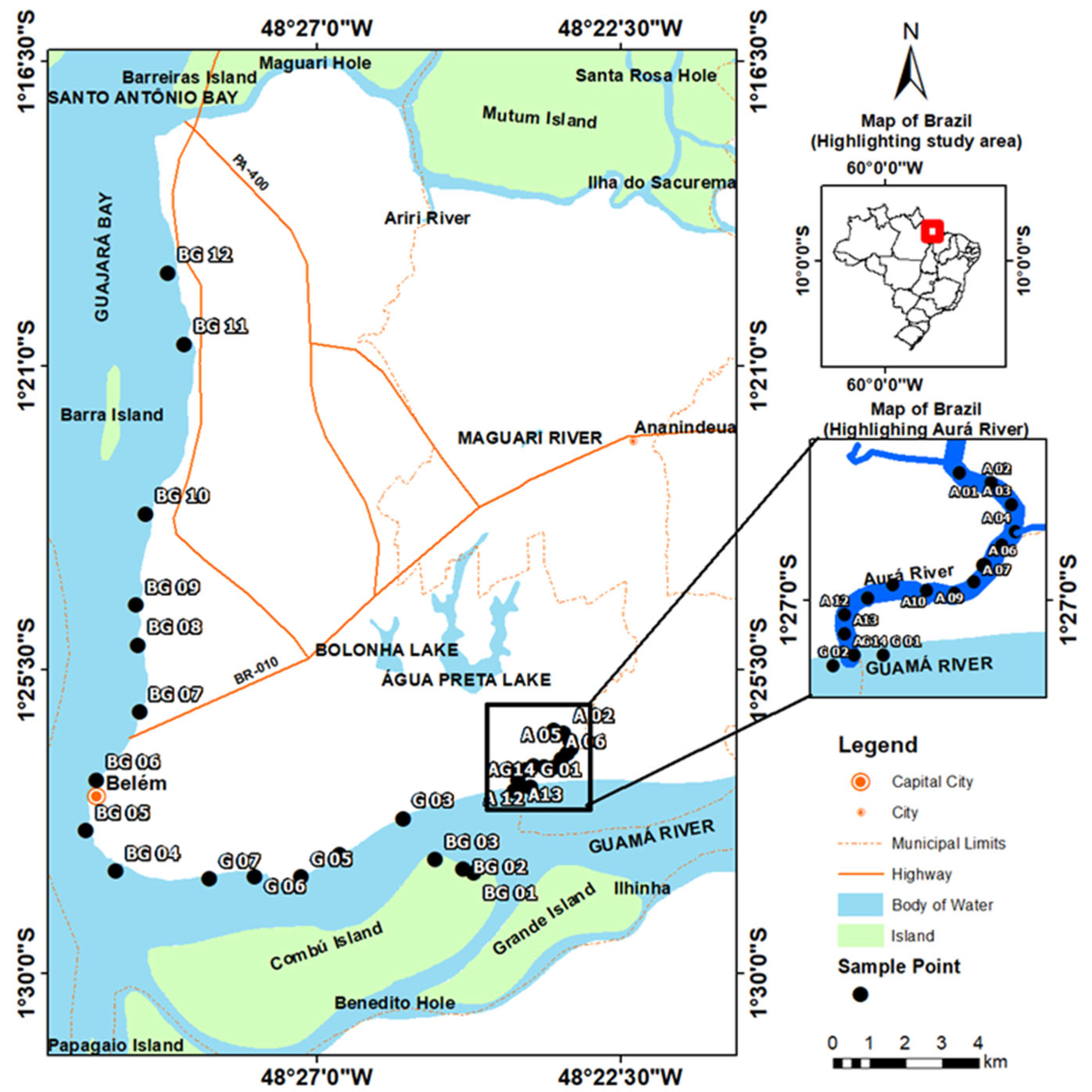
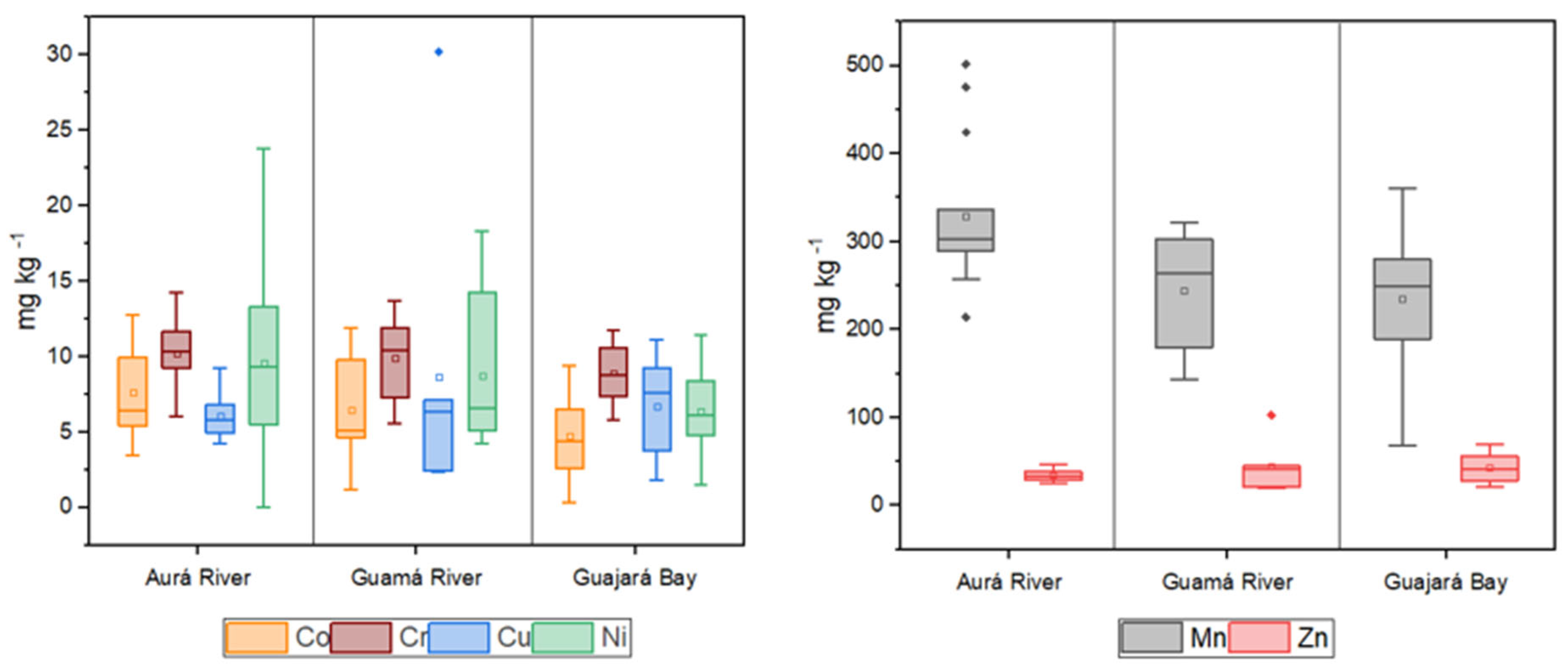

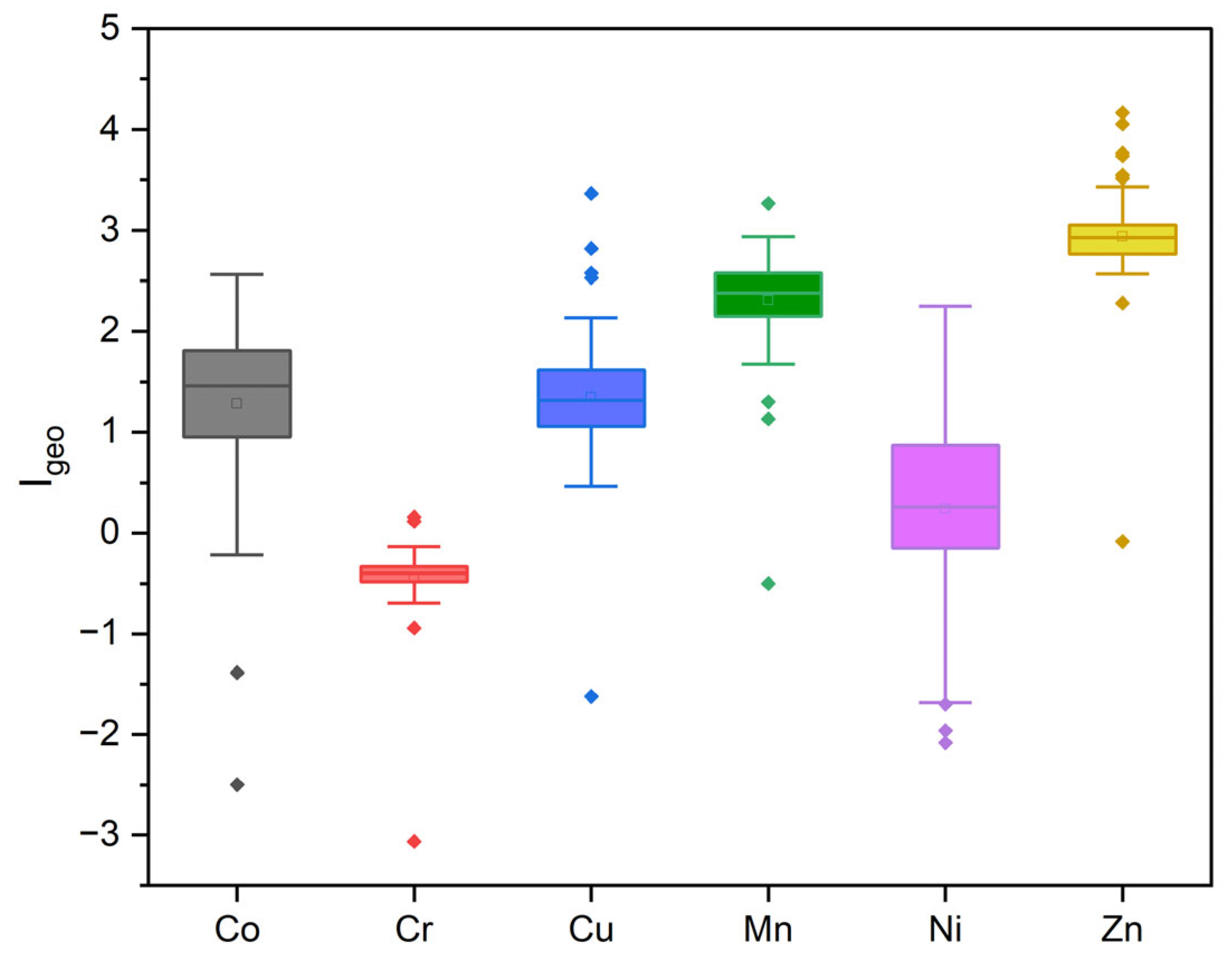
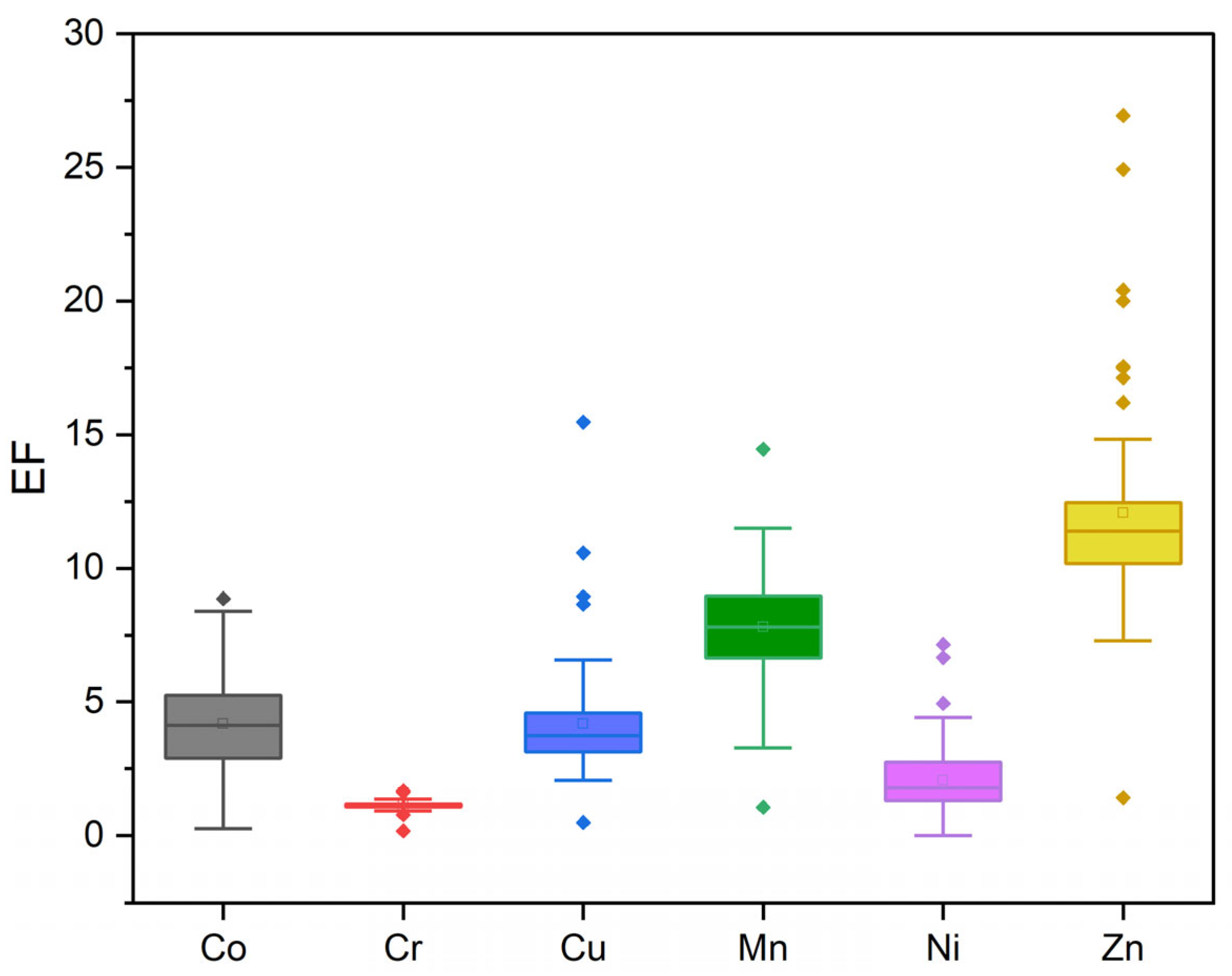
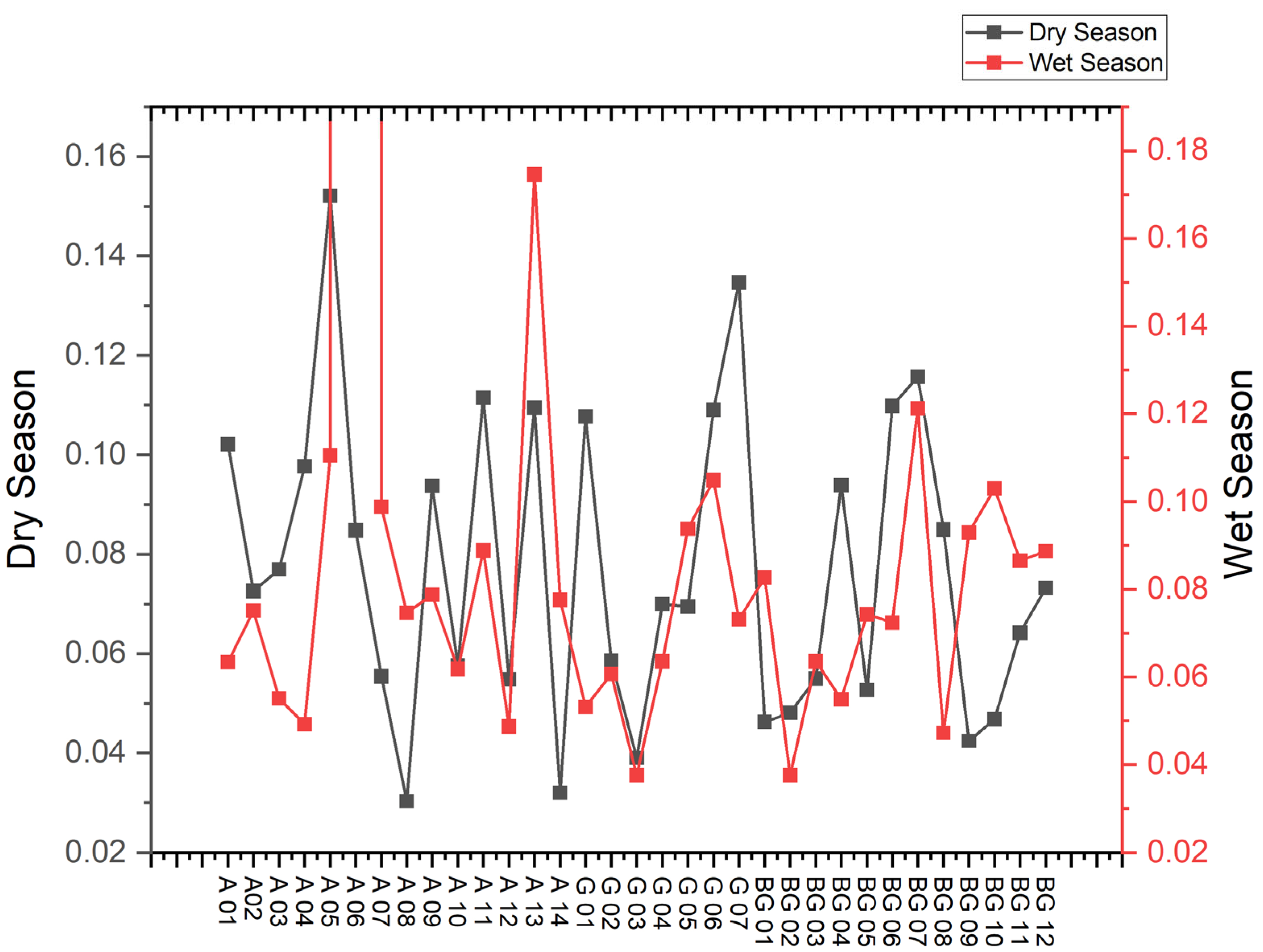


| Parameters | Conditions |
|---|---|
| RF Generator | 40 MHz |
| RF Power | 1.0 kw |
| Plasma Flow | 15 L min−1 |
| Auxiliary Gas Flow | 1.5 L min−1 |
| Flow of Nebulization gas | 0.7 L min−1 |
| Sample Pump Flow | 1.0 L min−1 |
| M-ERM-Q Value | Risk Level | Probability of Being Toxic |
|---|---|---|
| ≤0.1 | Low priority | 9% |
| 0.1 < M-ERM-Q ≤ 0.5 | Medium—Low priority | 21% |
| 0.5 < M-ERM-Q ≤ 1.5 | High—Medium priority | 49% |
| >1.5 | High priority | 76% |
| Metals | Range (mg kg−1) | Mean (mg kg−1) | SD (mg kg−1) | CV (%) | BV (mg kg−1) | TEL (mg kg−1) | PEL (mg kg−1) |
|---|---|---|---|---|---|---|---|
| Co | 0.35–12.91 | 6.50 | 3.01 | 46.29 | 38.00 | - | - |
| Cr | 5.55–24.52 | 10.64 | 2.86 | 26.98 | 228.00 | 37.3 | 90.0 |
| Cu | 1.80–30.20 | 6.49 | 3.83 | 59.04 | 37.40 | 35.7 | 197.0 |
| Mn | 68.64–557.73 | 296.37 | 92.72 | 31.29 | 929.00 | - | - |
| Ni | 0.046–29.09 | 8.28 | 5.16 | 62.28 | 99.00 | 18.0 | 35.9 |
| Zn | 19.68–102.87 | 38.97 | 13.82 | 35.45 | 79.00 | 123.1 | 315.0 |
| Corg | Sand | Silt | Clay | pH | Co | Cr | Cu | Mn | Ni | Zn | |
|---|---|---|---|---|---|---|---|---|---|---|---|
| Corg | 1 | −0.32 | 0.29 | 0.27 | 0.02 | 0.29 | 0.74 | 0.46 | 0.14 | 0.33 | 0.44 |
| Sand | −0.3 | 1 | −0.91 | −0.69 | 0.46 | −0.43 | −0.48 | −0.26 | −0.32 | −0.27 | −0.17 |
| Silt | 0.29 | −0.91 | 1 | 0.42 | −0.43 | 0.30 | 0.39 | 0.26 | 0.22 | 0.18 | 0.18 |
| Clay | 0.25 | −0.69 | 0.38 | 1 | −0.43 | 0.45 | 0.40 | 0.06 | 0.41 | 0.32 | −0.01 |
| pH | 0.02 | 0.47 | −0.43 | −0.33 | 1 | −0.24 | −0.57 | 0.01 | −0.11 | −0.19 | 0.17 |
| Co | 0.35 | −0.43 | 0.30 | 0.49 | −0.23 | 1 | 0.60 | 0.19 | 0.60 | 0.38 | 0.22 |
| Cr | 0.74 | −0.49 | 0.39 | 0.25 | −0.05 | 0.60 | 1 | 0.60 | 0.58 | 0.43 | 0.58 |
| Cu | 0.45 | −0.27 | 0.26 | 0.10 | 0.01 | 0.19 | 0.60 | 1 | 0.17 | 0.28 | 0.93 |
| Mn | 0.14 | −0.33 | 0.22 | 0.52 | −0.11 | 0.60 | 0.58 | −0.17 | 1 | 0.36 | 0.15 |
| Ni | 0.33 | −0.27 | 0.18 | 0.25 | −0.19 | 0.38 | 0.43 | 0.28 | 0.36 | 1 | 0.30 |
| Zn | 0.44 | −0.17 | 0.18 | 0.02 | 0.17 | 0.22 | 0.58 | 0.93 | 0.15 | 0.30 | 1 |
| Corg | Sand | Silt | Clay | pH | Co | Cr | Cu | Mn | Ni | Zn | |
|---|---|---|---|---|---|---|---|---|---|---|---|
| Corg | 1 | −0.32 | 0.34 | 0.21 | 0.18 | 0.17 | 0.35 | 0.02 | 0.20 | 0.12 | 0.21 |
| Sand | −0.32 | 1 | −0.99 | −0.94 | 0.30 | 0.24 | −0.09 | −0.05 | −0.05 | 0.11 | −0.01 |
| Silt | 0.34 | −0.99 | 1 | 0.93 | −0.29 | −0.25 | 0.11 | 0.05 | 0.07 | −0.10 | 0.01 |
| Clay | 0.21 | −0.94 | 0.93 | 1 | −0.26 | −0.31 | 0.09 | 0.05 | 0.01 | −0.12 | −0.01 |
| pH | 0.18 | 0.30 | −0.29 | −0.27 | 1 | 0.19 | 0.21 | 0.15 | 0.17 | −0.06 | 0.27 |
| Co | 0.16 | 0.24 | −0.25 | −0.31 | 0.19 | 1 | 0.22 | 0.18 | 0.39 | 0.26 | 0.21 |
| Cr | 0.35 | −0.09 | 0.11 | 0.09 | 0.21 | 0.22 | 1 | 0.63 | 0.67 | 0.42 | 0.71 |
| Cu | 0.02 | −0.04 | 0.04 | 0.05 | 0.15 | 0.18 | 0.63 | 1 | 0.22 | 0.11 | 0.88 |
| Mn | 0.20 | −0.05 | 0.07 | 0.01 | 0.17 | 0.39 | 0.67 | 0.22 | 1 | 0.16 | 0.30 |
| Ni | 0.12 | 0.11 | −0.10 | −0.12 | −0.06 | 0.26 | 0.42 | 0.11 | 0.16 | 1 | −0.07 |
| Zn | 0.21 | 0.01 | −0.01 | −0.01 | 0.26 | 0.21 | 0.71 | 0.88 | 0.30 | 0.07 | 1 |
Disclaimer/Publisher’s Note: The statements, opinions and data contained in all publications are solely those of the individual author(s) and contributor(s) and not of MDPI and/or the editor(s). MDPI and/or the editor(s) disclaim responsibility for any injury to people or property resulting from any ideas, methods, instructions or products referred to in the content. |
© 2025 by the authors. Licensee MDPI, Basel, Switzerland. This article is an open access article distributed under the terms and conditions of the Creative Commons Attribution (CC BY) license (https://creativecommons.org/licenses/by/4.0/).
Share and Cite
Souza, L.C.d.; Santos, C.C.d.; Vasconcelos Júnior, N.T.; Faial, K.d.C.F.; Corrêa, J.A.M.; Mendes, R.d.A. Trace Metals in Amazonian Rivers Sediments from Northern Brazil: Spatial-Temporal Variations, Sources, and Ecological Risks. Toxics 2025, 13, 891. https://doi.org/10.3390/toxics13100891
Souza LCd, Santos CCd, Vasconcelos Júnior NT, Faial KdCF, Corrêa JAM, Mendes RdA. Trace Metals in Amazonian Rivers Sediments from Northern Brazil: Spatial-Temporal Variations, Sources, and Ecological Risks. Toxics. 2025; 13(10):891. https://doi.org/10.3390/toxics13100891
Chicago/Turabian StyleSouza, Larissa Costa de, Camila Carneiro dos Santos, Neuton Trindade Vasconcelos Júnior, Kelson do Carmo Freitas Faial, José Augusto Martins Corrêa, and Rosivaldo de Alcântara Mendes. 2025. "Trace Metals in Amazonian Rivers Sediments from Northern Brazil: Spatial-Temporal Variations, Sources, and Ecological Risks" Toxics 13, no. 10: 891. https://doi.org/10.3390/toxics13100891
APA StyleSouza, L. C. d., Santos, C. C. d., Vasconcelos Júnior, N. T., Faial, K. d. C. F., Corrêa, J. A. M., & Mendes, R. d. A. (2025). Trace Metals in Amazonian Rivers Sediments from Northern Brazil: Spatial-Temporal Variations, Sources, and Ecological Risks. Toxics, 13(10), 891. https://doi.org/10.3390/toxics13100891







